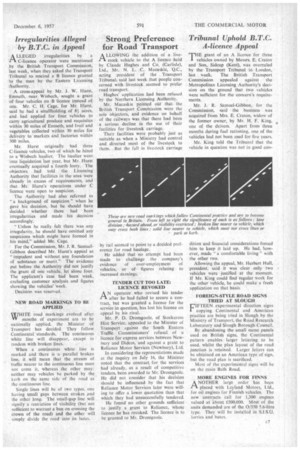Irregularities Alleged by B.T.C. in Appeal
Page 51

If you've noticed an error in this article please click here to report it so we can fix it.
A LLEGED irregularities by a C-licence operator were mentioned by the British Transport Commission, last week, when they asked the Transport Tribunal to rescind a B licence granted to the man by the Eastern Licensing -Authority.
A cross-appeal by Mr. J. W. Hurst, Emneth, near Wisivech, sought a grant of four vehicles on B licence instead of one, Mr. C. H. Cage, for Mr. Hurst, said he had a smallholding of Se acres, and had applied for four vehicles to carry agricultural produce and requisites within 30 miles of Emneth, and fruit and vegetables collected within 30 miles for delivery to markets and factories within 300 miles.
Mr. Hurst originally had three C-licence vehicles, two of which he hired to a Wisbech haulier, The haulier went into liquidation last year, but Mr. Hurst eventually acquired a• fourth lorry. The objectors had told the Licensing Authority that facilities in the area were already in excess of requirements, and that Mr. Hurst's operations under C licence were open to suspicion.
The Authority had also referred to "a background of suspicion" when he gave his decision, but he should have decided whether there had been irregularities and made his decision accordingly.
" Unless he really felt there was any irregularity, he should have omitted any suspicions which might have formed in his mind," added Mr. Cage.
• For the Commission, Mr. J. R. SamuelGibbon described Mr. Hurst's appeal as " impudent and without any foundation of substance or merit." The evidence put before the Authority did not justify the grant of one vehicle, lei alone four. The applicant's case had been weak, excluding customer analysis and figures showing the vehicles' work.
Decision was reserved.
NEW ROAD MARKINGS TO BE APPLIED
WHITE road markings evolved after. months of experiment are to be nationally applied, the Minister of Transport has decided. They follow Continental standards. The continuous white line will disappear, except in tandem with broken lines.
When a coetinuous white line is marked and there is a parallel broken line, it will mean that the stream of traffic nearer to the continuous line must not cross it. whereas the other may: neither may vehicles he parked by the kerb on the same side of the road as the continuous line.
Single lines will be of two types. one having small gaps between strokes And the other long. The small-gap line will signify a restriction of visibility (but not sufficient to warrant a ban on crossing the crown of the road) and the other will • simply divide the road into its lanes.
























































































































